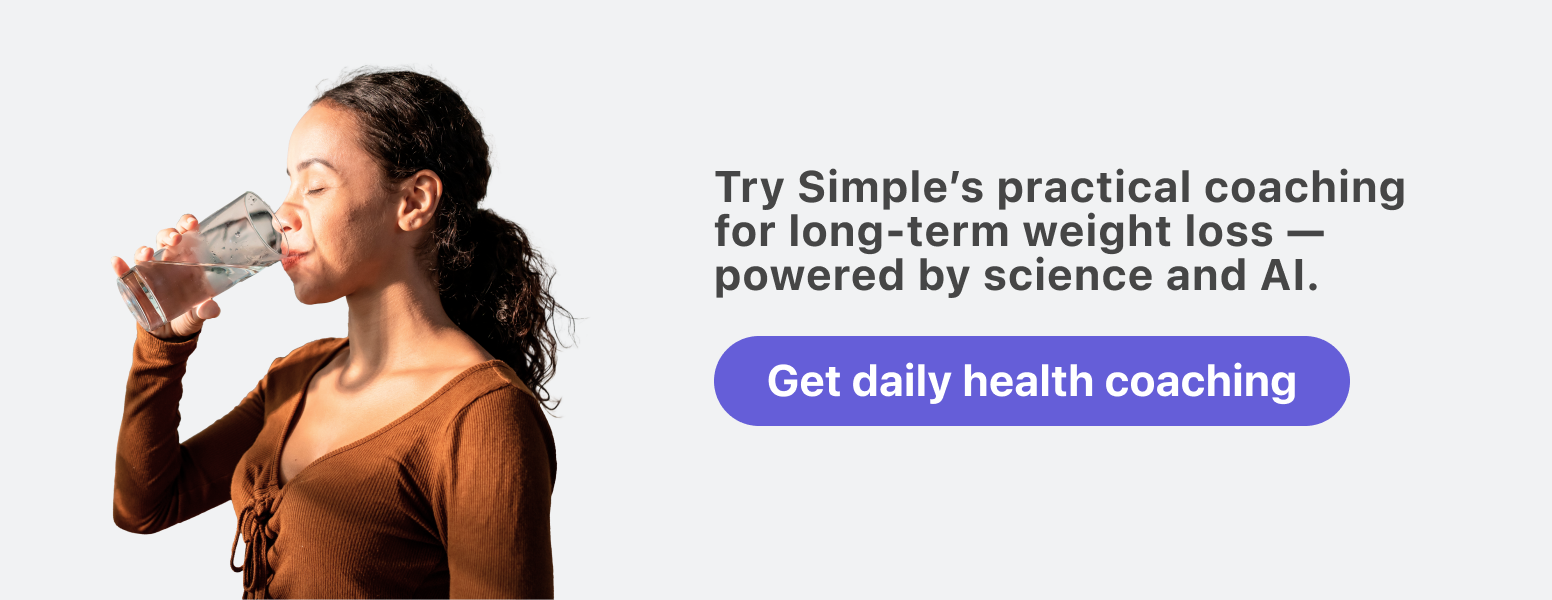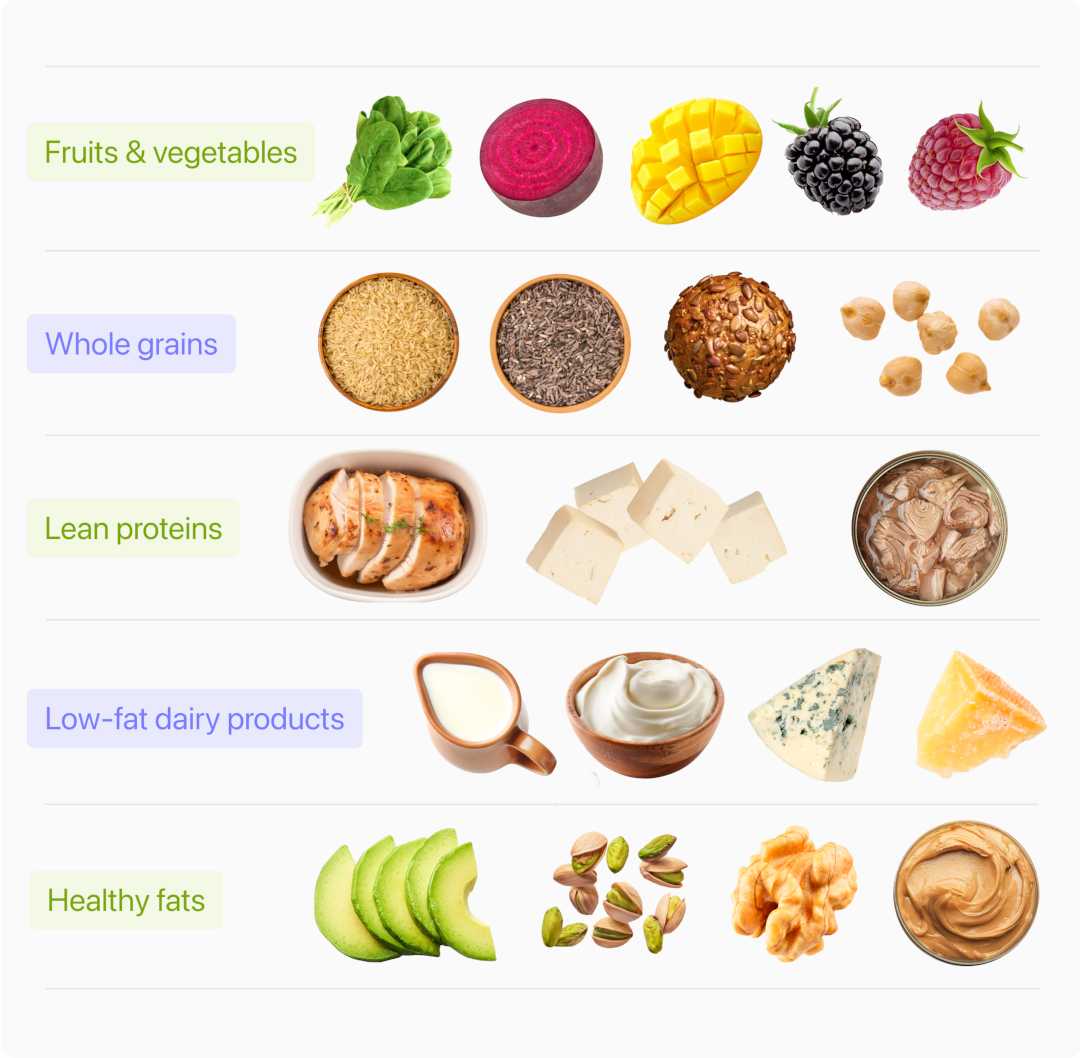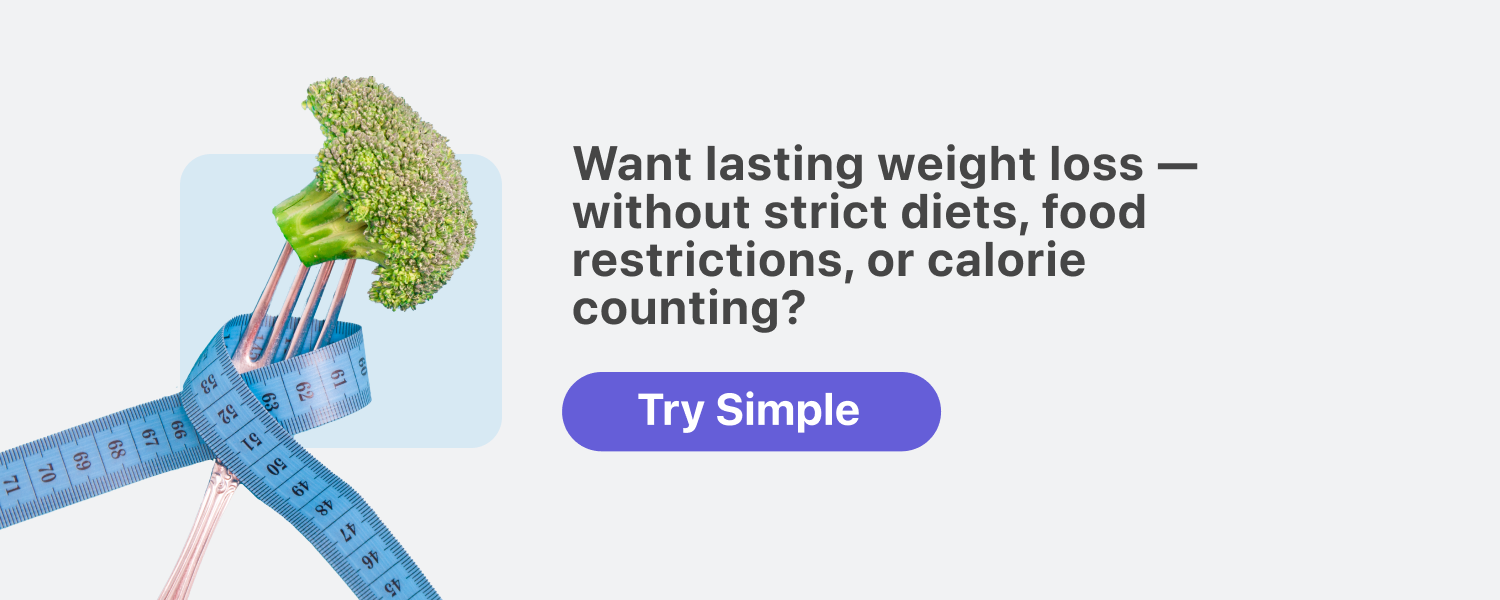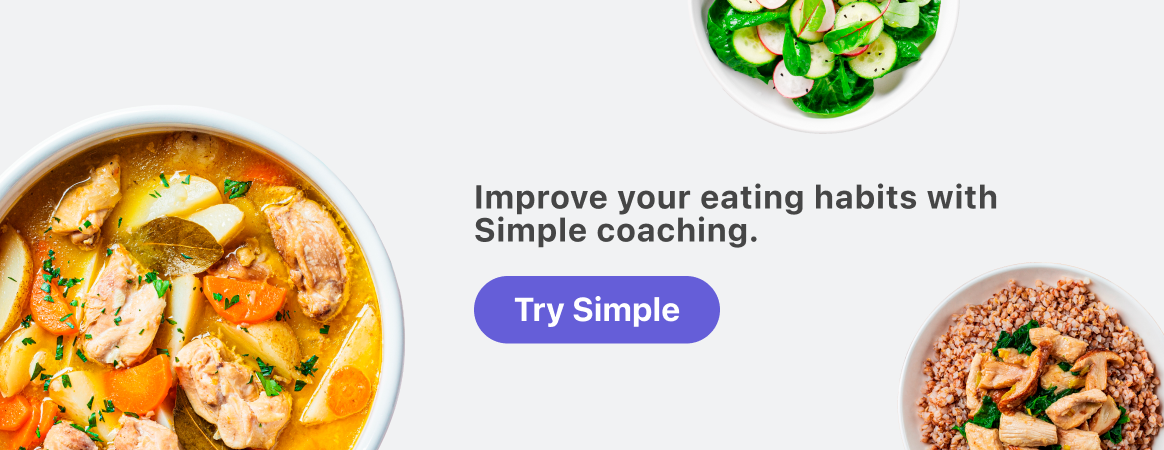Low-fat diet plan — the complete guide by Simple’s experts

Are you searching for a healthier lifestyle but not sure where to find it? [looks behind the couch]
It may sound pretty retro, but the answer may lie in a low-fat diet plan.
Yes, this diet was popular in the day of dayglo leg warmers and acid wash jeans, but the basic foundation — ditching high-fat foods like cakes and pastries in favor of more health-promoting options like veggies and chicken — can work really well for some people.

Following a low-fat diet plan can make a ton of sense for weight loss, and it can also help improve your heart health and reduce your risk of other health conditions like diabetes and cancer.[1]
This complete guide will take you through everything you need to know about a low-fat diet plan so that you get all the good stuff your body needs — and that your taste buds crave — just without the extra fat.
Ready to dive in? Let’s simplify this bad boy!
What does a low-fat diet meal plan look like?
As you probably guessed, low-fat diet plans emphasize consuming foods low in fat, particularly saturated and trans fats. That means sticking to lean proteins, plenty of fruits and vegetables, whole grains, and low-fat dairy products.
What does that look like in practice? Maybe something like this:
| Day 1 | Day 2 | Day 3 | Day 4 | Day 5 | |
|---|---|---|---|---|---|
| Breakfast | Greek yogurt with fresh berries | Overnight oats with chia seeds and cacao nibs | Banana, strawberry, spinach, and mint smoothie | Egg white omelet | Peanut butter and oat energy balls |
| Lunch | Lemon garlic chicken with wild rice and broccoli | Pesto-stuffed roasted mushrooms on quinoa | Grilled turkey with baked parsnip fries | Black bean and sweet potato tacos | Grilled vegetable kebabs and baked Parmesan zucchini |
| Dinner | Butternut squash soup with a slice of whole wheat bread | Salmon with sauteed kale | Chickpea pasta with stewed tomatoes | Pork chop and leek mashed potatoes | Cajun shrimp and pinto bean stew |
| Snack | Lightly salted popcorn | Roasted edamame with chili | Fresh raspberries, blueberries, or strawberries | Slices of apple and pepper jack cheese | Tomato bruschetta |
Not loving some of the sample meals here? If so, we gotcha. Here’s how to write a boss meal plan that suits both your needs and your tastebuds.
Simple’s here to help you stick to that meal plan, too, with our helpful food tracker to make sure you’re crushing it. Take our Simple quiz and get started today!
What is a low-fat diet, and how does it work?

There are actually two types of low-fat diets:
- low fat, which means less than 30% of your daily calories come from fat
- very low fat, which drops your daily calories from fat to less than 10% (we really don’t recommend this)
To put that into context: Say you ate a 2000-calorie diet. Low fat would mean eating less than 66 g of fat daily, and very low fat would mean eating less than 22 g. We suggest sticking to a low-fat diet, as a very low-fat diet can be hard to maintain and may cause nutritional deficiencies over time.[2]
Consuming too much fat in your diet can lead to weight gain and increase your risk of developing heart disease.[3] By lessening the amount of fat you eat, you could lose / maintain your weight more easily and boost your health in the bargain.
We know a low-fat style of eating can seem a bit, well, dull. If you’re thinking, “Dang it, Simple, fat’s the thing that makes everything taste good!” we hear you.
Yes, it does — but it’s not the only thing that can bring flavor to your plate and palate. There are plenty of ways to do that without all the extra calories that fat brings, and you can even make low-fat versions of your favorite foods (cookbooks are your friends!) Plus, even if your favorites are burgers and triple-fried fries, no foods are ever completely off-limits, and you call the shots on when you get the real deal.
You also don’t have to overhaul your entire diet overnight. It’s 100% OK to gradually lessen your intake of higher-fat foods and increase your intake of lower-fat foods.
In fact, this “slowly, slowly” approach works better than big, sweeping changes, so take it slow and steady. Over time, aim to eat more fruits, vegetables, and whole grains and less high-fat foods like cheese, butter, and chocolate.

What should I eat when on a low-fat diet plan?
When following a low-fat diet meal plan, focus on eating plenty of fruits, vegetables, whole grains, lean protein, and low-fat dairy products.
Shoot for a less frequent intake of ultra-processed and fried foods, like cakes, chips, bacon, etc. These tend to be higher in fat, sugar, and calories and lower in nutrients.
All this can feel a little abstract, we know. What foods fit into what categories? Let’s break it down.
Foods to eat on a low-fat diet meal plan
Most low-fat diet meal plans will include the following foods:
- fruits and vegetables, including berries, peas, and leafy greens
- whole grains, including brown rice, wholemeal pasta, and quinoa
- lean proteins, such as chicken, tofu, tempeh, tuna and other fish
- low-fat dairy products, such as milk, yogurt, and cheese
- healthy fats, including nuts, seeds, and avocados in moderation
Foods to avoid on a low-fat diet meal plan
On a low-fat diet, these foods would be limited to “occasional use only”:
- fried foods, including fries and chicken nuggets
- fatty cuts of meats, such as ribeye steak and pork belly
- processed meats, including sausages and bacon
- full-fat dairy products, such as cheese, cream, and whole milk
- high-fat snacks, like chips, cookies, and cakes
- oils and fats, like margarine, lard, and butter
- sugary drinks, such as soda, energy drinks, and fruit juices with added sugars
As a general rule of thumb, aim to eat every 3–4 hours and shoot for a lean protein source and some veggies at each meal.

This applies even if you’re following an intermittent fasting schedule like intermittent fasting 16:8 or any other variation of time-restricted eating. (Though you might need to adjust the timing if you have a shorter eating window.)
Not into the idea of planning something yourself? Take our Simple quiz so we can get to know your goals, needs, and preferences. Then we’ll handle all the organizational heavy lifting!
The low-fat diet and weight loss results
A low-fat diet could help you create the weight loss results you’re looking for.
By reducing your intake of high-calorie, fatty foods, you can more easily create that all-important calorie deficit. This means you’ll burn more calories than you consume, and your body will start using stored fat for energy, resulting in weight loss.
If you’re eager to know more about how to create a calorie deficit to burn fat, this will help. And, even though fat loss vs. weight loss isn’t the same thing, burning fat will reliably lead to weight loss.

Low-fat diet vs. low-carb diet
No discussion about low-fat diets is complete without highlighting the difference between low-fat and low-carb. Let’s take a closer look at how they compare.
A low-carb diet plan involves reducing foods high in carbohydrates, including bread, pasta, grains, cookies, and cakes. The goal is to encourage the body to use fat for energy instead of glucose, which can lead to weight loss and better overall health by maintaining blood sugar levels and lowering the risk of heart disease.[4]
A low-fat diet, as we’ve seen, involves reducing foods that are high in fat, such as fatty meats, full-fat dairy products, and fried foods. The aim is to encourage your body to use the fat it has stored instead of dietary fat. This leads to many benefits, including weight loss, lower cholesterol levels, and a reduced risk of heart disease.[5]
The choice between low-carb and low-fat diets is yours to make. Both can lead to positive results, and studies suggest there’s little difference between the two in terms of effectiveness.[6]
Which one works best for you will come down to which style of eating you most enjoy.
Health benefits of the low-fat diet
Going low fat could net you more than weight loss. There are a number of ways this style of eating could benefit your health.
Lower risk of heart disease
A diet high in saturated fats or trans fats can clog your arteries and increase your risk of heart disease.[7]
Your taste buds will thank you
Believe it or not, going low fat could actually transform your taste buds! By cutting out excess fat, you’ll be able to taste the natural flavors of your food more.
A speedier metabolism
A low-fat diet plan can help shift your metabolism,[8] possibly by making our bodies more sensitive to insulin, a hormone that helps our muscles take up more sugar from food.
While more evidence is needed before we can get too excited, it’s certainly a welcomed extra.
Health risks of the low-fat diet
It’s worth also noting some of the risks of a low-fat approach.
You may miss out on important nutrients
Not all fats are unhealthy. Omega-3s, for instance, are essential for good health.
Include monounsaturated fats and omega-3-rich foods — like oily fish, nuts and seeds, and olive oil — in your low-fat diet plan so you don’t become deficient in key nutrients like vitamins E and K.[9]
Ideally, don’t go below 15% of your calories coming from fat.[10]
You may feel more hungry
Fats are important in helping you feel full and satisfied after a meal.[11] Without enough fat intake, you might find yourself feeling hungry and craving comfort foods.
You might not see the results you want
While reducing your intake of unhealthy fats can help you lose weight, if you consume more calories than you burn, you won’t see the results you want, regardless of whether you’re following a low-fat diet plan or not.
You might develop an unhealthy relationship with food
Following a strict diet can sometimes lead to disordered eating patterns and an unhealthy relationship with food.
Pros and cons of a low-fat diet
| Pros | Cons |
| Weight loss | Increased risk of nutrient deficiencies |
| Reduced risk of heart disease | Increased risk of depression and anxiety |
| Improved cholesterol levels | Limited food choices |
| Better digestion | Increased hunger and cravings |
| Reduced risk of certain cancers | Difficult to sustain |
Pros
Following a low-fat diet plan has several possible benefits, such as weight loss, reduced risk of heart disease, improved cholesterol levels, better digestion, and reduced risk of certain cancers (including bowel and colon).[12,13]
Cons
However, there are some potential drawbacks to a low-fat diet plan, including an increased risk of nutrient deficiencies, limited food choices, increased hunger and cravings, increased risk of depression and anxiety, and difficulty sticking to the diet long term.[14,15]
Is a low-fat diet right for you?
So, you’re thinking of jumping on the low-fat diet bandwagon? Well, hold those horses — before you ride off into the sunset together, let’s see if low fat is the right partner for you.
First things first, low-fat diets aren’t for everyone.
Sure, they can help you shed some pounds and reduce your risk of certain illnesses, but if you have specific nutritional needs or a medical condition, chat with your doctor or registered dietitian before making any changes.
And let’s not forget about sustainability.
If you’re not someone who enjoys snacking on carrot sticks and rice cakes, then a low-fat diet plan may feel like a struggle. (Although you could become this person with a little time and practice if you wanted to.)
You may find yourself better suited to other dietary methods like intermittent fasting. If you’re curious about that, check out our intermittent fasting for beginners guide.
Here’s the bottom line about low fat:
It’s no more effective than any other popular diet like low carb, Mediterranean, keto, or paleo when it comes to losing weight.[16]
If you like the sound of it, try it. You may thrive! If not, no worries. There are loads of other ways to improve your eating habits and hit your goals.
Try our Simple quiz, and we can help you try some new things. Maybe you’ll fall in love with intermittent fasting. Or use our food tracker to increase your awareness of your food choices. Or simply read some of our articles to understand how to build new habits, how stress might be holding you back, or how to squash emotional eating.
5 tips to get started on a low-fat diet

If you’re excited and ready to get going with a low-fat diet plan, here are five key tips to help:
- Read food labels
Three top tips here:
- Start paying attention to the fat content of the foods you eat.
- Avoid processed foods that are high in saturated fat and trans fat.
- Choose either low-fat or fat-free options with less than 3 g of fat per serving.
- Get in your healthy fats
While you’re minimizing unhealthy fats, remember that your body still needs fat to function. Get in your unsaturated fats like omega-3s by eating oily fish up to a couple times a week, cooking with a little olive oil, and snacking on a small handful of nuts.
- Increase your intake of fruits and vegetables
These sorts of foods are naturally low in fat and packed with nutrients. Aim to make them the foundation of your meals.
- Choose lean protein sources
Lean protein sources like chicken, turkey, fish, low-fat yogurt, milk, and legumes are wonderful choices for a low-fat diet. Avoid fatty cuts of meat and processed meats like bacon and sausage.
- Plan your meals
Planning your meals ahead of time can help you stick to your diet. Find some time during your week to sit down, plan some breakfasts, lunches, and dinners, and make your grocery list!
Frequently asked questions about the low-fat diet plan
On a low-fat diet, you should eat a broad range of foods including fruits, vegetables, whole grains, lean proteins, and low-fat dairy products.
Aim to limit your intake of ultra-processed and high-fat foods like chips, cookies, and candy.
There are lots of things you can eat for a breakfast that is low in fat. Try oatmeal, fresh fruit, yogurt, or whole grain toast with a light spread like margarine.
Eat the high-fat options like bacon or croissants less often. Although they’re not low in fat, higher protein foods like eggs or nut butters can help you keep you fuller throughout the morning.
At Simple, we’re fans of time-restricted eating, like 16:8 and 18:6. We’re not super keen on Eat Stop Eat, water fasting, or any fast that lasts longer than 18 hours!

- Prentice RL, Aragaki AK, Howard BV, Chlebowski RT, Thomson CA, Van Horn L, et al. Low-Fat Dietary Pattern among Postmenopausal Women Influences Long-Term Cancer, Cardiovascular Disease, and Diabetes Outcomes. J Nutr. 2019 Sep 1;149(9):1565–74.
- Whitfield-Brown L, Hamer O, Ellahi B, Burden S, Durrington P. An investigation to determine the nutritional adequacy and individuals experience of a very low fat diet used to treat type V hypertriglyceridaemia. J Hum Nutr Diet. 2009 Jun;22(3):232–8.
- Wali JA, Jarzebska N, Raubenheimer D, Simpson SJ, Rodionov RN, O’Sullivan JF. Cardio-Metabolic Effects of High-Fat Diets and Their Underlying Mechanisms-A Narrative Review. Nutrients [Internet]. 2020 May 21;12(5).
- Barber TM, Hanson P, Kabisch S, Pfeiffer AFH, Weickert MO. The Low-Carbohydrate Diet: Short-Term Metabolic Efficacy Versus Longer-Term Limitations. Nutrients [Internet]. 2021 Apr 3;13(4).
- Chawla S, Tessarolo Silva F, Amaral Medeiros S, Mekary RA, Radenkovic D. The Effect of Low-Fat and Low-Carbohydrate Diets on Weight Loss and Lipid Levels: A Systematic Review and Meta-Analysis. Nutrients [Internet]. 2020 Dec 9;12(12).
- Lei L, Huang J, Zhang L, Hong Y, Hui S, Yang J. Effects of low-carbohydrate diets versus low-fat diets on metabolic risk factors in overweight and obese adults: A meta-analysis of randomized controlled trials. Front Nutr. 2022 Aug 9;9:935234.
- Hooper L, Martin N, Jimoh OF, Kirk C, Foster E, Abdelhamid AS. Reduction in saturated fat intake for cardiovascular disease. Cochrane Database Syst Rev. 2020 Aug 21;8(8):CD011737.
- Kahleova H, Petersen KF, Shulman GI, Alwarith J, Rembert E, Tura A, et al. Effect of a Low-Fat Vegan Diet on Body Weight, Insulin Sensitivity, Postprandial Metabolism, and Intramyocellular and Hepatocellular Lipid Levels in Overweight Adults: A Randomized Clinical Trial. JAMA Netw Open. 2020 Nov 2;3(11):e2025454.
- Bracci EL, Keogh JB, Milte R, Murphy KJ. A comparison of dietary quality and nutritional adequacy of popular energy-restricted diets against the Australian Guide to Healthy Eating and the Mediterranean Diet. Br J Nutr. 2022 Oct 14;128(7):1357–70.
- Park S, Ahn J, Lee BK. Very-low-fat diets may be associated with increased risk of metabolic syndrome in the adult population. Clin Nutr. 2016 Oct;35(5):1159–67.
- Moris JM, Heinold C, Blades A, Koh Y. Nutrient-Based Appetite Regulation. J Obes Metab Syndr. 2022 Jun 30;31(2):161–8.
- Murphy EA, Velazquez KT, Herbert KM. Influence of high-fat diet on gut microbiota: a driving force for chronic disease risk. Curr Opin Clin Nutr Metab Care. 2015 Sep;18(5):515–20.
- Wan Y, Wu K, Wang L, Yin K, Song M, Giovannucci EL, et al. Dietary fat and fatty acids in relation to risk of colorectal cancer. Eur J Nutr. 2022 Jun;61(4):1863–73.
- Fatemi F, Siassi F, Qorbani M, Sotoudeh G. Higher dietary fat quality is associated with lower anxiety score in women: a cross-sectional study. Ann Gen Psychiatry. 2020 Feb 26;19:14.
- Entwistle TR, Green AC, Fildes JE, Miura K. Adherence to Mediterranean and low-fat diets among heart and lung transplant recipients: a randomized feasibility study. Nutr J. 2018 Feb 14;17(1):22.
- Koliaki C, Spinos T, Spinou Μ, Brinia ΜE, Mitsopoulou D, Katsilambros N. Defining the Optimal Dietary Approach for Safe, Effective and Sustainable Weight Loss in Overweight and Obese Adults. Healthcare (Basel) [Internet]. 2018 Jun 28;6(3).
